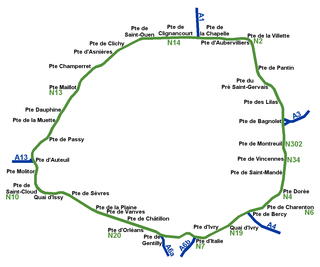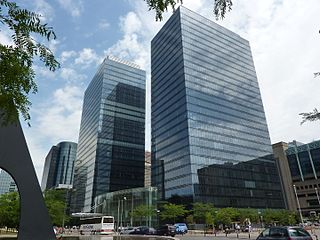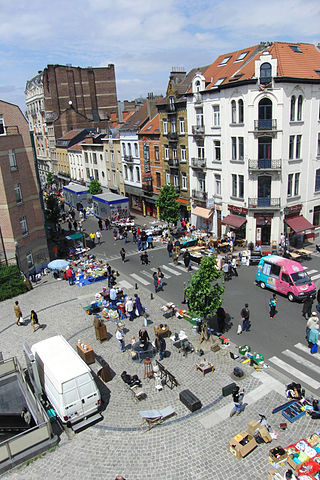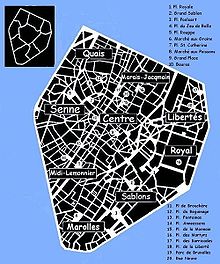
The City of Brussels is the largest municipality and historical centre of the Brussels-Capital Region, as well as the capital of the Flemish Region and Belgium. The City of Brussels is also the administrative centre of the European Union, as it hosts a number of principal EU institutions in its European Quarter.

The Brussels tramway network is a tram system serving a large part of the Brussels-Capital Region of Belgium. It is the 16th largest tram system in the world by route length, in 2017 providing 149.1 million journeys over routes 140.6 km (87.4 mi) in length. In 2018, it consisted of 18 tram lines. Brussels trams are operated by STIB/MIVB, the local public transport company.

Chaussée d'Antin–La Fayette is a station on Line 7 and Line 9 of the Paris Métro. The station was opened on 5 November 1910 with the opening of the first section of the line from Opéra to Porte de la Villette. The line 9 platforms opened on 3 June 1923 with the extension of the line from Saint-Augustin.

Hendrik Beyaert (Dutch) or Henri Beyaert (French) was a Belgian architect. He is responsible for the designs of the Palace of the Nation, the National Bank of Belgium and Bornem Castle, among many other significant buildings.

The Fortifications of Brussels refers to the medieval city walls that surrounded Brussels, Belgium, built primarily to defend the city but also for administrative reasons. There were two stages of fortifications of Brussels: the first walls, built in the early 13th century, and the second walls, built in the late 14th century and later upgraded. In the 19th century, the second walls were torn down and replaced with the Small Ring, a series of boulevards bounding the historical city centre. Nowadays, only a few sections of each walls remain, most notably the Halle Gate.

The Halle Gate is a former medieval city gate and the last vestige of the second walls of Brussels, Belgium. Built between 1381 and 1383, it was heavily restored in the 19th century in its current neo-Gothic style by the architect Henri Beyaert. It is now a museum dedicated to the medieval City of Brussels, part of the Royal Museums of Art and History (RMAH).

Porte de Hal or Hallepoort (Dutch) is a rapid transit station in Brussels, Belgium, consisting of both a metro station and a premetro station. The station is located in the municipality of Saint-Gilles, south of the City of Brussels, under the Small Ring and next to the 14th-century Halle Gate, after which it is named. It is one metro stop away or about ten minutes' walk from Brussels-South railway station.

Porte de Namur or Naamsepoort (Dutch) is a Brussels Metro station on the southern segment of lines 2 and 6. It is located under the Small Ring at the Square du Bastion/Bolwerksquare, next to the Chaussée d'Ixelles/Elsense Steenweg, in the municipality of Ixelles, south of the City of Brussels, Belgium. The station takes its name from the Namur Gate area, itself named after the Namur Gate in Brussels' old city walls.

While Paris is encircled by the Boulevard Périphérique, the city gates of Paris are the access points to the city for pedestrians and other road users. As Paris has had successive ring roads through the centuries, city gates are found inside the modern-day Paris.

The Northern Quarter is the central business district of Brussels, Belgium. Like La Défense in Paris, the Docklands in London or the Zuidas in Amsterdam, the Northern Quarter consists of a concentrated collection of high-rise buildings where many Belgian and multinational companies have their headquarters.
The N1 is a national route that connects Brussels with Antwerp and the Dutch border near Wuustwezel.
The Greater Ring or Intermediate Ring is a series of roadways in Brussels, Belgium, intermediate between the Small Ring and the main Brussels Ring motorway. Most of this set of roads is numbered R21 and is about 30 km (19 mi) long, compared to 8 km (5.0 mi) for the Small Ring and 80 km (50 mi) for the main Ring.

The tram route 51 in Brussels, Belgium, is a tram route operated by STIB/MIVB, which connects Heysel/Heizel metro station in the City of Brussels to the Van Haelen stop in the municipality of Uccle. The route runs north–south, crossing the City of Brussels, Jette, Molenbeek-Saint-Jean, the City of Brussels again, Saint-Gilles, Forest and Uccle. Currently, service is interrupted between Brussels-South railway station and Altitude Cent/Hoogte Honderd due to construction work at Albert premetro station.

The tram route 82 in Brussels, Belgium, is a tram route operated by STIB/MIVB, which connects Berchem-Sainte-Agathe railway station in Berchem-Sainte-Agathe to Drogenbos Castle in the Flemish municipality of Drogenbos. After 8 p.m., the route terminates at Brussels-South railway station, with connections to Drogenbos provided by tram route 32.

Line 2 is a rapid transit line on the Brussels Metro in Belgium operated by STIB/MIVB. It has existed in its current form since 4 April 2009, when the section between Delacroix and Gare de l'Ouest/Weststation was opened, which allowed to close the "loop" from and to Simonis/Elisabeth. The configuration of Simonis/Elisabeth though does not allow trains on line 2 to perform the loop several consecutive times in the same direction, i.e. a train running clockwise from Elisabeth will have to run counterclockwise from Simonis. The two termini of line 2 have thus received different names: originally Simonis (Elisabeth) and Simonis , changed in November 2013 to Elisabeth and Simonis. Between Yser/IJzer and the Porte de Hal/Hallepoort, the line runs under the Small Ring, which was itself built on the site of the former second walls of Brussels. The line crosses the municipalities of Koekelberg, Molenbeek-Saint-Jean, City of Brussels, Saint-Gilles and Anderlecht.
The North–South Axis is a tram tunnel in Brussels, Belgium, which crosses the city centre from north to south between Brussels-North railway station and Albert premetro station.

The Namur Gate was one of the medieval city gates of the second walls of Brussels, Belgium. Built in the 14th century, it was demolished in 1784 during the construction of the Small Ring.
The N23 is a short national highway in the Brussels Capital Region, Belgium. It is one of the busiest roads within the capital with daily gridlock during the rush hours.

The Chaussée de Waterloo or Waterloosesteenweg (Dutch), is a long north–south arterial road from Brussels to Waterloo, Belgium. It begins at the Halle Gate in the Brussels municipality of Saint-Gilles, continues a course towards the south-east until the Bascule area of Uccle, then turns south in the direction of Waterloo, where it changes its name to become the Chaussée de Bruxelles and continues in the direction of Genappe and Charleroi (Wallonia) until the regional border. Its length is 12.4 kilometres (7.7 mi) and its width between 15 and 18 metres.


















